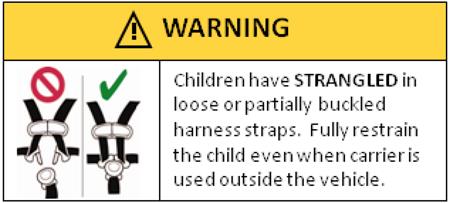Did you know that NHTSA is not the only government agency that oversees CRs? That’s because RF-only CRs with handles are also considered carriers. To enhance the safety of carriers, a new Consumer Products Safety Commission (CPSC) standard goes into effect on June 6, 2014. It applies to RF-only CRs as well as any other rigid- or semi-rigid-sided, hand-held carrier (i.e.: portable cradles and Moses baskets). Watch for this new label to appear soon on the padding around the head area of all RF CRs. It can be used to introduce caregivers to the topic of appropriate use of CRs, both in and out of the vehicle.
The mandatory standard is in response to the Danny Keysar Child Product Safety Notification Act of 2008, which required the CPSC to establish a standard that would be equal to or more stringent than a voluntary carrier standard, ASTM F2050-13a, that was first established in 2000 (with many subsequent updates). The Act was named after Danny Keysar, a 16-month-old from Illinois who, like at least 16 other children, died by strangulation in a portable crib. The standard focuses on handle integrity and internal restraints of carriers in order to mitigate the risk that infants will fall or get into a position in which they can be strangled or suffocated.
The new rule establishes “Safety Standard for Hand-Held Infant Carriers” (www.regulations.gov, search Docket No. CPSC-2012-0068). Other than expanding the scope to include semi-rigid carriers, the standard replicates all elements of the previously voluntary standard. Therefore, makers of rigid-sided carriers like CRs have been aware of (and in most ways adhering to) the following requirements for many years:
- Carry handle integrity: The handle must pass a series of endurance and durability tests to ensure it will not break or unlock during use.
- Carry handle auto-locking: The handle design must prevent it from switching positions unexpectedly.
- Restraint: The carrier must have a restraint, such as a harness, that will minimize the hazard of falls and the incidence of suffocation or strangulation when properly used.
- Slip resistance: The carrier must not slip when placed on a slightly inclined surface (10 degrees).
- Marking and labeling: The carrier must have hazard warnings. For CRs, this involves a pictogram on the padding, near the head area (see example above).
Although manufacturers indicate that today’s RF CRs already meet or exceed most of the standard’s requirements, the notable exception is the requirement to display a strangulation-warning label. Expect to see this new label sharing the padding area near the existing air-bag-warning label on RF-only CRs soon.
In the rule, NHTSA states that data show that the majority of infant fatalities in hand-held carriers were tied to improper or nonuse of a carrier’s internal restraint system (harness), so it will be important for caregivers to note and heed this new label. The label can also be used by CPSTs as a visual cue to engage in educational discussions with caregivers on this topic.

